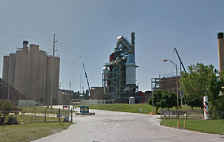Concrete is the most manufactured material in the world, with Portland cement, which binds it, accounting for about 8% of global carbon dioxide (CO2) emissions. For perspective, cement makers in China alone (highest producer by country) spewed out 858 million metric tons of CO2 in 2020, according to market data company Statista.
As governments set carbon reduction goals, and as the green building industry booms, the hunt is on for sustainable technologies to clean up the roughly 65 to 95 tons of CO2 emitted per ton of cement. Carbon capture and storage technologies will be key to making headway, attests the International Energy Agency, an organization that vets sustainable energy policies.
Carbon removal technology company CarbiCrete is among the few who seems to be on course. It’s found a way to make cement-free concrete, while trapping CO2 inside it. It’s running a commercial-stage pilot, backed by the government of Canada and Quebec, at concrete manufacturer Patio Drummond’s plant.
The pilot, now in process, will in its final stage produce 450 tons of concrete per day (25,000 blocks), which will capture about 20 tons of CO2, according to Mehrdad Mahoutian, chief technology officer and co-founder of CarbiCrete.
A key feature is the capture and sequestration of CO2 using steel slag, a by-product of steel manufacturing.
“We get steel slag from manufacturers, grind it, and mix it with aggregate and water to make concrete. But it’s weak without cement,” Mahoutian says.
He addresses the strength problem by leveraging an alternative to heat in order to create a bond between materials to fortify the concrete. It’s done through a chemical reaction between slag and CO2 to form calcium carbonates, which act as the binder and give the concrete its strength.
How it works is the mixture of steel slag and other materials are poured into a machine where the concrete masonry units are formed. They are placed in an absorption chamber, where the CO2 is injected into the fresh concrete
“We are basically curing material with CO2 so it reacts in the presence of water, and the concrete gains strength. At the same time, we capture [and permanently sequester] CO2, avoid landfilling, and use less natural resources.”
The product performs as well as cement-based concrete (in some scenarios better) based on CarbiCrete’s internal trials and third-party testing.
Test results show, compared to conventional cement, the product has the same water absorption properties but better compressive strength (up to 30% more), indicating resistance to cracking and breaking under force. And it has better strength against freezing and thawing.
It will work for masonry units, retaining walls, sidewalks, paving yards, or as replacement in other precast concrete products used in construction.
And its potentially cheaper than conventional alternatives. Material costs are 10 to 20% lower because product is made with trash or byproduct, avoiding a roughly $200 a ton expense for cement.
Pilot participant Patio Drummond who makes concrete landscaping products currently manufactures all its concrete with Portland cement.
The plan is to convert all dry cast concrete production within three years to the CarbiCrete technology. When the full switch happens, the company figures it will reduce more than 15,000 tons of cement, says Philippe Girardin, director of Innovation, Patio Drummond.








